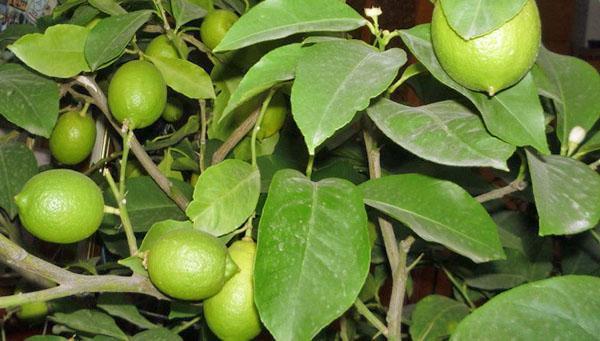Learning to grow and care for lemon at home
 The agrotechnics of growing citrus fruits in a room is complex. You should start with lemon, growing and caring for it at home is easier for it than for other sissies. You can buy a young bush, or you can grow it, starting from sowing a seed or rooting a cuttings. Under all favorable conditions, a crop from a seed plant can be obtained in 20 years, from a cuttings in 7-8. But a lemon from a stone at home will be more fit, healthy, beautiful with its dark shiny foliage. It can be grafted with a shoot from a fruiting lemon, which will speed up flowering. The choice is for the amateur.
The agrotechnics of growing citrus fruits in a room is complex. You should start with lemon, growing and caring for it at home is easier for it than for other sissies. You can buy a young bush, or you can grow it, starting from sowing a seed or rooting a cuttings. Under all favorable conditions, a crop from a seed plant can be obtained in 20 years, from a cuttings in 7-8. But a lemon from a stone at home will be more fit, healthy, beautiful with its dark shiny foliage. It can be grafted with a shoot from a fruiting lemon, which will speed up flowering. The choice is for the amateur.
What kind of care does a room lemon require at home

- Pavlovsky;
- Anniversary;
- Mayer.
These varieties are distinguished by a quick entry into fruiting and high productivity when caring for lemon at home. When buying a finished varietal seedling, you need to wait for flowering in two or three years.
Indoor lemon with good care can live up to 30 years. Lemon after tying is poured for 9 months, but after it continues to increase in size, but becomes tasteless and thick-skinned.
It is important not to allow the flower to weaken and cut off the buds until there are 20 leaves on the bush. Scientists believe that each fruit is fed by 9-10 mature leaves. Depending on the number of leaves, you need to leave the harvest. For the same reason, you need to protect the leaves from shedding, with which the plant protests when it is uncomfortable. At the same time, pruning of the tops of the branches is mandatory in order to form new shoots, which means to increase the number of leaves. Therefore, plant care is carried out on the verge of knowledge and intuition.
Optimal conditions for lemon care
Only if you have a spacious, bright room can you count on creating a citrus garden. Even being in a constant place, the tree does not like to be moved. And for uniform development, it is rotated a few degrees after 10 days, so that a full revolution is obtained in a year:
- There must be at least two meters from the stand to the ceiling.
- Dry air lemon can't stand it. Optimum 70% humidity. This means keeping the plant away from the radiator, having a humidifier or an aquarium, equipping the moisture zone in any way possible, and often spraying the leaves with a fine spray.
- In summer, it is useful for a lemon to stay under the sun for 2 hours, but not longer. Therefore, the morning sun on the east window is just right for him. In winter, when growing lemon and care at home should be organized backlight 5-6 hours.
- The content temperature for lemon should be between 14 and 27 degrees. During the flowering period, the lemon needs coolness.
- The watering schedule in summer is very busy. The pot is watered twice a day, morning and evening, soaking the clod completely. Due to good drainage, stagnation of water does not occur. There should be a drip tray underneath. For irrigation, soft, settled water is used.
The temperature should not change dramatically. If the plant is brought from a cold veranda into a warm room, it will shed its foliage.The ground in the barrel is cold and the leaves are warm! In winter, you need to find the coldest corner of your home for a lemon. Without a full dormant period, flowering will be meager in the future.
 Of great importance in caring for a lemon is its formation, keeping it in growth with systematic pruning and pinching of the green cone. The deepest pruning is done in the spring. 5-6 live leaves are left on the branches, the rest are removed, and material for the propagation of lemon by cuttings is obtained from them.
Of great importance in caring for a lemon is its formation, keeping it in growth with systematic pruning and pinching of the green cone. The deepest pruning is done in the spring. 5-6 live leaves are left on the branches, the rest are removed, and material for the propagation of lemon by cuttings is obtained from them.
Diseases and pests of lemon
When caring for lemon at home, and growing it, you need to know the signs of disease in order to quickly correct the mistakes made. Often the plant needs moisture, which can be determined:
- from above the earth is gray, a lump is crumbling in the hands;
- the pot, when patted, makes a ringing sound;
- the leaves curled up into a tube, and the tops drooped.
As a result, after a while, the leaves, flowers and ovaries will begin to fall off.
If the plant does not receive feeding, the leaves become light, flowering stops, the ovaries begin to fall off. But the same signs and with excessive fertilization. Therefore, it is necessary to follow the recommended doses and instructions on how to take care of lemon at home.
If the plant has not been transplanted for a long time and the land has not been changed, fertilizing watering may not save it. The earth has compacted, the irrigation water has made passages in the thickness and is drained, not completely wetting the volume.
 As a result of errors in care, a weakened plant is colonized by insect pests or fungal and bactericidal diseases appear.
As a result of errors in care, a weakened plant is colonized by insect pests or fungal and bactericidal diseases appear.
Various citrus diseases are specific, they are called:
- xylopsorosis and tristera - viral incurable;
- gommosis - infectious when the trunk of a tree is affected;
- malseko - infectious, begins with reddening of the leaves, the tree dies;
- root rot is a fungal disease, it is required to remove the damaged parts and transplant into new soil.
 The cause of any disease is improper care of the plant. And even if the tree does not bear fruit, it has the same diseases.
The cause of any disease is improper care of the plant. And even if the tree does not bear fruit, it has the same diseases.
How to grow lemon at home
The selection of the container for the plant and the substrate is of great importance. The container must have good drainage holes. The root system of the lemon is compact, the young plant treats the annual transplant well, so it is not worth creating conditions for acidification of the soil in a large pot. For older plants, the land is changed less often, but the upper fertile layer is renewed annually.
 Composition of the earth:
Composition of the earth:
- deciduous humus - 2 parts;
- humus from cattle - 1 part;
- washed river sand - 1 part;
- wood ash - 0.25 parts.
At the bottom, put a layer of charcoal mixed with expanded clay, add vermiculite to the substrate for friability. Transplant plants after the grown lemon roots are wrapped around a clod of earth, using the transshipment method.
 When pruning a lemon tree, a lot of planting material and twigs remained. Cuttings will be made from them if you pinch off a couple of leaves from below and put a green twig in the water. Further, the cutting takes root in the substrate in a small volume. How to care for lemon cuttings? After the cutting has given a leafy growth, it is kept as an adult plant. At a height of 25 cm, the top of the plant is pinched, limiting growth. The formed central and lateral shoots in the amount of 4 pieces are left, the rest are cut off into a ring.
When pruning a lemon tree, a lot of planting material and twigs remained. Cuttings will be made from them if you pinch off a couple of leaves from below and put a green twig in the water. Further, the cutting takes root in the substrate in a small volume. How to care for lemon cuttings? After the cutting has given a leafy growth, it is kept as an adult plant. At a height of 25 cm, the top of the plant is pinched, limiting growth. The formed central and lateral shoots in the amount of 4 pieces are left, the rest are cut off into a ring.
Lateral shoots are grown 25 cm and pinched again, repeating the operations as for the first time. A bush is formed twice more, as a result, enough leaves are obtained on a round tree, and flower buds are laid on the branches. The lemon is ready to bear fruit, it has gained enough strength to feed the pouring fruits.
Seed propagation of lemon is a lengthy process. The resulting seedling must be grafted in order to get a fruiting tree.The wildflower will develop for a long time, bloom little and the quality of the lemons obtained will be poor. Therefore, a grown plant needs to be grafted by budding or into splitting in order to get a cultivated tree.
A seedling without grafting will make an excellent ornamental tree with good disease resistance. It is necessary to form the crown so that the bush is neat and does not stretch with branches, taking up a large space.